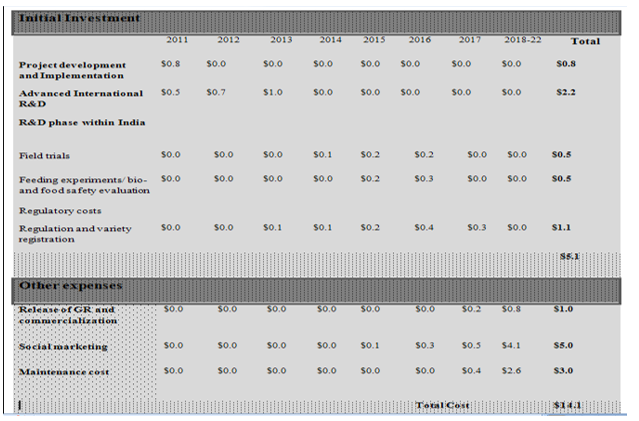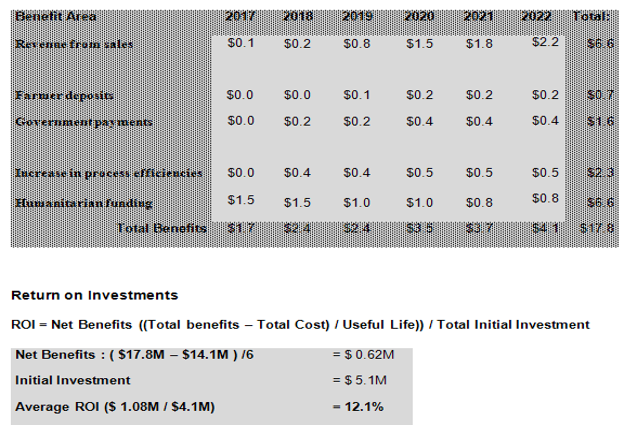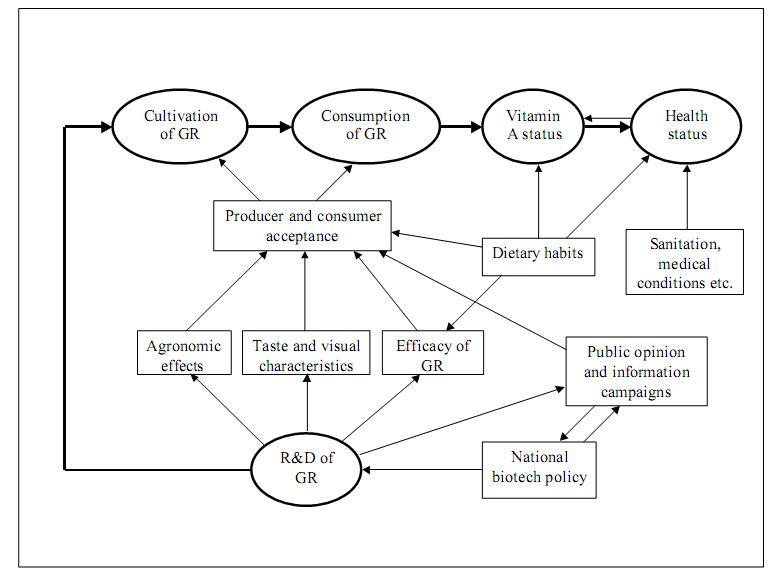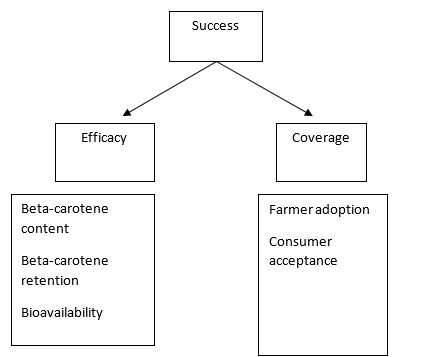Background
Vitamin A deficiency is most prevalent in diets that are primarily cereal-based with little consumption of meat or fresh vegetables. Pharmaceutical supplementation and food fortification with vitamin A (VA) are commonly practiced, but these programs have their shortcomings.
The inventors conceived Golden Rice exclusively as a humanitarian product for resource poor farmers in developing countries.
ABC Consulting
We provide specialized technological advice and expertise assisting organizations involved in research and commercialization of biotechnology in improving their methods and efficiency of production, and approaches to R&D along with helping in making their project practically feasible with the current market scenario.
Clients Overview
This project of engineering rice for high β-Carotene content is infact one of 44 projects being funded through the Grand Challenges in Global Health Initiative which was launched by the Bill & Melinda Gates Foundation in 2003 to encourage scientists to find the solutions that will revolutionize prevention and treatment of disease in developing countries.
Biosynthetic pathway for provitamin A in rice was done by transforming with a construct containing a phytoene synthase gene from daffodil {Ye X, 2000 #2}.
The consortium considers this project to be in the advanced development phase with the goal of market entry in India in 2017.
They have also informed us that if we can prove this newer variety of Golden Rice to be safe and effective, there would be ample humanitarian funding available to assist with marketing the product.
Statement of Purpose
Our project objective is to advise the ProVitaMinRice Consortium about the feasibility of their Golden Rice project by conducting an analysis for the product through a test market and investigating its sustainability by measuring its opportunities and threats.
The Way We Look at This Project
The basic research consists of three phases (the first two phases have been completed):
- Phase I – isolation of genes coding for enzymes making up the beta-carotene synthesis pathway.
- Phase II – Transformation of rice so that they express their enzymes in the rice endosperm.
- Phase III – Analysis of the transformed rice plant. This is our initial objective.
We would also assess the quantity and bioavailability of beta-carotene being produced and the changes in plant growth due to new genes.
Shifting from greenhouse to the field will then become our major objective.
Finally we will be focusing on proper marketing of the product and creating public awareness.
Phase III would help ensure that the synthesis pathway is functioning and producing beta-carotene in the endosperm.
In shifting from greenhouse to the field, we will have to introduce of the beta-carotene producing characteristics into local rice varieties grown in India and then do a nutritional and safety testing before releasing it into agriculture. After introduction into agriculture, a new phase of continuous monitoring by biologists, nutritionists and agronomists will be launched to examine the impact of Golden Rice on people’s health and on agriculture in India.
Financial Justification
The following table shows the estimated cost of R&D and technology testing and dissemination in India.
All figures are in million units.

The estimated cost is based on personal communication with Dr Adrian C Dubock, project manager of a similar project (PVMRC project); and based on a successfully proven concept in 1999{Ye, 2000 #4}.
The three year Advanced International R&D phase would include the verification and improvement of available gene constructs and mainly their incorporation into popular indica varieties. It is important to note here that we are in the advanced phase of R&D, and so the cost of this phase is much lesser than what would have been had we not yet developed our product.Next, a three-year R&D phase within India is undertaken which would include field trials, feeding experiments, and bio- and food safety evaluation. The total cost for this six years of R&D and testing is estimated at around $4.1 million. The regulatory processes would start one year before beginning the R&D phase in India, include variety registration, biosafety and food safety evaluation and these costs are based on estimates by the Biosafety Program South Asia.
Furthermore, we have also taken into account expenditures of $5.0 million towards the end of the testing phase for a broad information campaign, including efforts like printing promotional leaflets, radio and TV broadcasts, and training rural extension staff. Once the GR varieties are commercially released, a recurrent annual cost of $0.4 million is assumed for germplasm maintenance and monitoring.
The following is a breakdown of the revenue flow till the end of the project duration.
All figures are in million units.

The total cost of this project is hence estimated to be around $14.1 million. The above cost structure confirms the argument that GR can be a very sustainable intervention once the initial investments in R&D and variety dissemination are made. The consumer price of GR is expected to be equal to conventional rice. We know that provided we can prove this product to be safe and effective, funding would not be a problem.
We however need to let the board know whether they are making a worthwhile investment and how much exactly of an impact this product of theirs will have in the Indian market. We would hence determine the current public disease burden of VAD in the country, and simulate to what extent this burden could be reduced through GR{Paine, 2005 #6} and we also assess the cost-effectiveness of GR and compare the results with the cost-effectiveness of alternative VA interventions and other public health programs. This is discussed towards the end of the report.
Strategic Justification
The problem of VAD has been recognized, and over the past two decades, a large number of countries have embraced VA control with the aim of reducing VAD in their countries.
To fortify rice with provitamin A, the use of biotechnology is required.
India is chosen as a target market for GR with an objective of reducing VAD.
Just a Part of the Bigger Picture
This project is one of the 44 projects being funded through the Grand Challenges in Global Health Initiative.
The following image shows the seven long term goals of the Grand Challenges in Global Health Initiative.

This project of “Engineering High Beta-carotene Rice for India” is part of the fourth goal of “improving nutrition”. The other projects in this category are:
Biocassava Plus African Biofortified Sorghum Project, and Micronutrient Improved Bananas
The large majority of VA-deficient people live in developing countries. There are a lot of food crops that contain naturally a high amount of beta-carotene. Examples include fruits, leafy vegetables, and some roots crops like sweet potatoes and carrots. Although a diversified diet with high amount of beta-carotene can provide enough of VA, many poor people in developing countries cannot afford such balanced diet. Rice, which is a staple food in a large part of Asia – does not contain beta-carotene in the endosperm. To fortify rice with provitamin A, the use of biotechnology is required. A second generation of GR with higher beta-carotene content has now been developed.
Considering this improved variety, and after analyzing the potential health benefits of GR to reduce VAD among rice consumers, by using the disability-adjusted life years; India was rightly chosen as the country to market this product in, not because of any financial benefits, but mainly for the sheer impact that this project could have on reducing VAD in the country.
The Golden Rice project is hence part of a collection of projects grouped together which are not necessarily interdependent or directly related. This initiative was launched by the Bill & Melinda Gates Foundation in 2003 to encourage scientists to find the solutions that will revolutionize prevention and treatment of disease in developing countries.
This project of “Engineering High Beta-carotene Rice for India” addresses the problem of micronutrient malnutrition in rice and is a collaborative, international effort that includes seven working groups working together as the so-called ProVitaMinRice Consortium.
Project Success Criteria


In the figure 1, the ellipses and bold arrows indicates the way through which GR has to be taken from the stage of R&D to agricultural production to the level of consumption. The progress within the research process plays a huge part in how fast the technology leaves the stage of R&D.
Even though our variety of GR contains 31.6 µg/g beta-carotene compared to 6 µg/g of beta-carotene for the earlier variety; we are still aware that there is scope for loss of beta-carotene content due to post-harvest treatment, storage, processing and even normal cooking. During the advanced R&D phase we will be giving this issue a high priority and would be looking for ways to minimize the loss of beta-carotene content.
On the other hand, the consumer and producer acceptance of GR will be a very crucial factor. Producers would be interested in knowing possible agronomic consequences associated with this technology and, consumer acceptance problems might occur because of the yellow color of the grain. So as to prevent price discounts (which would lower adoption incentives for farmers) and achieve wide-spread consumption, we will employ a strong social marketing and information campaign two years before the release to promote GR adoption by farmers and acceptance among consumers. At this stage, the concrete design of these activities is still somewhat unclear but we have taken this into consideration in the budget.
Finally this project is designed to meet all schedule dates and to work with the allocated budget. A strong risk management system has also been laid to rule out any kind of uncertainty in the near future. All objectives and quality requirements will be met by this project.
Realization of Benefits
In order to assess the impact of an increased intake of VA on this disease burden through future consumption of GR, we have used the Disability-Adjusted Life Years (DALYs) approach, popularized in “The Global Burden of Disease” report (Murray, 1996#5).
According to calculations{ALEXANDER J. STEIN, 2008 #11}, the current burden of VAD in India amounts to 2.3 million DALYs lost each year. 71,625 preschool children die each year because of VAD, and 3,663 go blind; 2.6 million pregnant and lactating women and 1.6 million children suffer from night blindness, and 0.8 million children succumb to measles {ALEXANDER J. STEIN, 2008 #11}. It is predicted by {Stein, 2006 #8} that depending on the amount of beta-carotene and the consumer acceptance, Golden Rice could reduce the burden of VAD in the country by 8.8-54.9%.
Expected benefits are to be realized in 12 years time if social marketing campaign works.
Obtaining a 12.1% ROI would be ideal.
The projects aims to reduce the burden of VAD by 45% or above 30%.
The ProVitaMinRice Consortium has started this project, through social marketing campaigns, mainly for humanitarian purposes; but that being said they would like to see a return of their investment. So obtaining a 12.1% ROI at the end of twelve years would be ideal, but getting consumer acceptance and knowing their product is serving its needs would be more satisfying. Finally the project would aim for reducing the burden of VAD in the country by 45%, but anything above 30% would also be considered satisfactory.